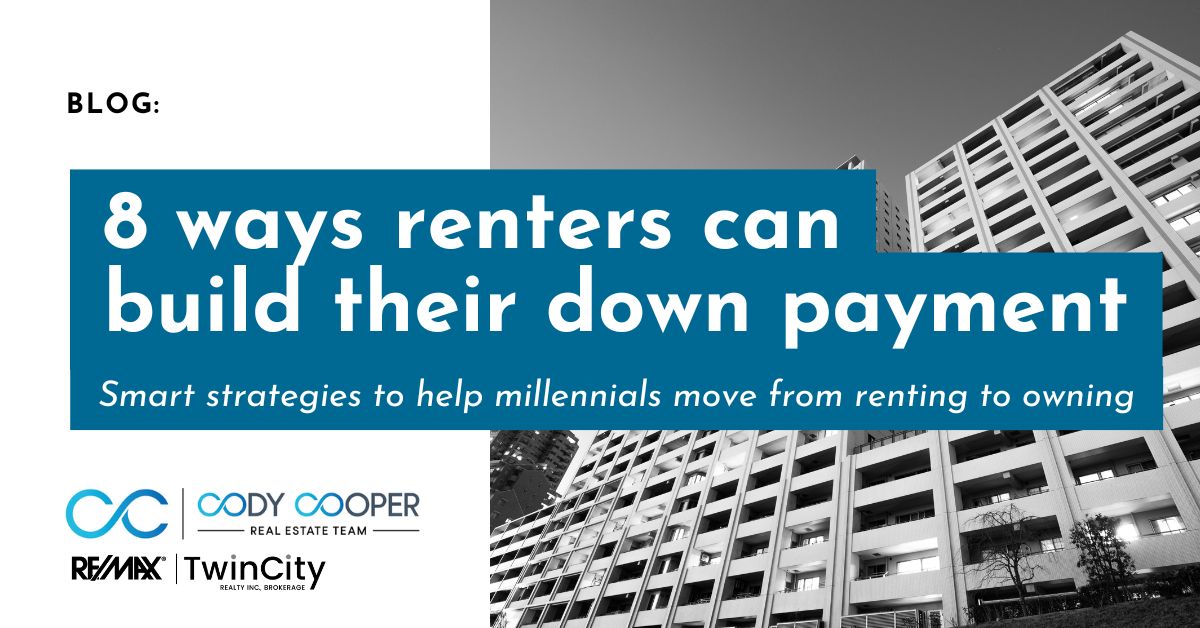For many millennials, owning a home feels like a distant dream, especially when you’re renting in cities where rent is rising fast. But saving up a down payment doesn’t have to be impossible. With smart planning, a few lifestyle adjustments, and leveraging available programs, renters can build toward homeownership. Here are some strategies that millennials can use to save a down payment.
1. Create a budget you’ll actually stick to
The first step is laying out what you really earn vs what you really spend.
“When you have a plan for where your money is going, it puts the power back in your hands and gives you an idea of how long it will take to save for a down payment.”
RE/MAX Canada
Write down your monthly income, list all your expenses, and include a savings goal in that list. You’ll want your expenses to stay below your income; otherwise, you’ll accumulate debt instead of savings. Tracking your spending is vital so you can see what can be trimmed.
2. Tackle debt so it doesn’t hold you back
High debt makes it harder to qualify for a mortgage. Lenders look at your “debt-to-income” (DTI) ratio. If too much of your income is already going toward repaying existing loans or credit card balances, that’s a red flag.
“If you work to cut down your existing debt while saving for your down payment, you can get approved for the house you want.”
RE/MAX Canada
Even small payments toward debt (especially high-interest debt) can free up more money down the line, both in what you can spend and in improving your creditworthiness.
3. Cut back on little extras that add up
Changing daily habits can free up surprising amounts of money.
- Make meals instead of ordering out. Tip: plan your meals and cook in batches.
- Cancel or downgrade unused subscriptions like streaming platforms, apps, and gym memberships. Be sure to check your credit card and bank statements to understand where your money is going each month. Take a quick look now to see if you’re paying for something you don’t use.
- Use public transit or a carshare program instead of owning or driving a car where possible. If you can manage without owning a car, you can save on your monthly payment, gas, insurance, parking and maintenance costs.
But it’s also important to remember that while trimming expenses, keep room for the things you enjoy doing. Allocate “fun” money within your budget and make sure you stick to it. Balance is key!
4. Find ways to save on rent
Since rent is likely your largest monthly expense, reducing it can have big effects:
- Move to a cheaper apartment if possible.
- Consider relocating to an area with lower cost of living if you work from home.
- Find a place closer to work to reduce commuting costs.
Whatever savings you get from adjusting your rent should immediately go into your down payment fund.
5. Look for chances to boost your income
Once you’ve looked at cutting costs, start exploring ways to increase your income.
- Freelancing or side gigs. Offer skills like writing, design, tutoring, or coding on platforms.
- Part-time or weekend work. Take on shifts at retail, restaurants, or seasonal jobs for steady extra cash.
- Monetize hobbies. Sell art, crafts, baked goods, or photography through local markets or online.
- Offer services in your community. Pet sitting, dog walking, babysitting, or lawn care can bring in flexible income.
- Rent out a room or parking space. Platforms like Airbnb or local classifieds can generate passive income.
- Sell unused items. Clothing, electronics, and furniture can be sold on Facebook Marketplace or Poshmark.
- Turn knowledge into tutoring or coaching. Help students with school subjects or adults with professional skills.
- Negotiate a raise or promotion at your current job. Sometimes the best income boost is maximizing your main source.
- Invest in short-term contracts or seasonal overtime. Many industries hire extra staff during busy periods.
Even small extra amounts can help shrink how long it takes to reach your goal.
6. Put windfalls like bonuses or gifts toward savings
When windfalls happen (a tax return, a work bonus, or even birthday/holiday gifts) use them to boost your down payment savings.
“If you receive regular bonuses … these can easily be contributed toward your down payment savings without sacrificing your quality of life.”
RE/MAX Canada
You might also ask people to give you contributions toward your down payment instead of traditional gifts for birthdays or weddings. It’s all about redirecting “extra” money you’d have spent anyway.
7. Take advantage of government programs that help first-time buyers
Millennials in Canada have special programs to help:
- First Home Savings Account (FHSA): If you’re a first-time buyer, you can save up to $8,000 annually, up to a lifetime maximum of $40,000. Contributions are tax deductible, and withdrawals to buy a first home are tax-free.
- Registered Retirement Savings Plan (RRSP) via Home Buyers’ Plan (HBP): You may withdraw up to $60,000 from your RRSP (without the usual tax penalty) if you’re a first-time home buyer.
These tools can accelerate your progress, but they require discipline: consistent contributions, staying informed about rules, and planning how these fit with your long-term financial goals.
8. Remember: saving is a long game, not a quick win
Don’t expect overnight success. Saving enough for a down payment takes time.
Using a mix of budgeting, debt reduction, extra income, and government programs gives you the best chance of reaching your target without burning out.
Wondering how much you should aim to save?
Every dollar saved brings you closer to your first set of keys. If you’re starting to picture what homeownership could look like for you, we’re here to help make it happen. Let’s connect and explore the options that can get you into your first home sooner than you think.




